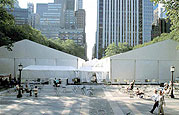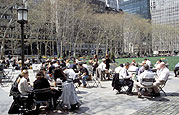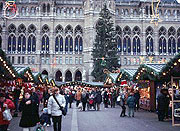If the majority of America's parks aren't going to stagnate, they're going to need to learn from those parks that are getting it right.
 Massive budget cuts in U.S. cities, combined with a growing focus on urban revitalization and walkable cities, puts urban parks in the spotlight as never before. Effectiveness is the name of the game, and however you look at it, there's no doubt that the most effective parks are the ones that are best used.
Massive budget cuts in U.S. cities, combined with a growing focus on urban revitalization and walkable cities, puts urban parks in the spotlight as never before. Effectiveness is the name of the game, and however you look at it, there's no doubt that the most effective parks are the ones that are best used.
But it's not just a matter of attracting lots of people; it's a matter of having a diversity of people, who are attracted by a range of things to do, throughout the year.
Which is why it is so remarkable that, although people profess to love parks, many parks are failing to attract people. Take a look for yourself in towns and cities across the country, and you'll see parks and plazas galore that have little happening in them at all.
The problem is that there's an art to successful park design and management -- an art that we seem to be losing. Basic elements -- such as comfort, sociability, access and activities -- seem to have slipped through the cracks as more and more parks fail to meet the mixed and varied needs of their visitors.


Even high-profile parks are showing signs of being in trouble. New York's Bryant Park -- famed for a renovation that brought crowds to a once-derelict hangout for drug dealers - is one example. While its lush lawns and convenient moveable chairs make it a heavily used place for much of the year, it is increasingly given over to private interests. At the main park entrance, Starbucks has taken the place of local coffee purveyors. And the park is virtually inaccessible to regular folk for up to a month each year, due to the semi-annual Mercedes-Benz New York Fashion Week (including set up and recovery). Despite its innovative history, Bryant Park has become a victim of its own success and is cutting itself off from the public it ought to be serving.
While Bryant Park suffers as a result of corporatization, Denver's Skyline Park has been condemned because of over-design and then abandonment. Described by Rocky Mountain News editor and publisher, John Temple as a "bold vision, but flawed", the 3.2-acre park was completed in 1973 with the aim of renewing a blighted area of the city. The problem is that the sole path through the park goes nowhere, offering only concrete walls and ledges for comfort. Overflowing garbage cans, cigarette butts and chipped wooden benches are a clear sign of a park that got left behind. (It's now slated for a controversial redesign.)
Granted, most parks are not at the epicenter of Midtown Manhattan, nor are they as dramatically neglected as Skyline Park. But it's not just the high-profile places that are at risk. Nibbled away for parking lots and office blocks, hijacked by single-issue recreational groups from dog owners to Little Leaguers, over-designed by the very people trying to save them - America's everyday parks are also facing challenges.
So which ones are getting it right? They are the ones that have dedicated people who are willing to think creatively, innovate and listen to their range of users.
It's always inspiring to look outside the U.S for examples, such as the Paris Plage, a smash hit last summer. With a ribbon of sand, umbrellas, cafes and volleyball courts, Mayor Bertrand Delanoë temporarily transformed 3.8 kilometers of inner-city expressway along the Seine River into an urban beach (displacing hundreds of thousands of motorists in the process). Seventeen city agencies worked together to create this temporary park, equipped with 80 imported palm trees, 22 changing tents, 150 parasols and 300 blue canvas deckchairs.

Besides all these accoutrements, there was plenty to do at Paris-Plage: a string of cafes, music and dance floors, climbing walls, volleyball, boules, and putting greens. Despite taking place during the dog-days of summer, when Paris empties Three million people visited the Paris-Plage in its first week, 600,000 on the first day alone.
Vienna's Rathaus/City Hall Park is another good example. Surrounded by some of the city's most treasured buildings, the park is one of the city's most popular destinations for locals and tourists alike. It is used all year round for concerts, festivals, markets and even small-scale tennis tournaments. But the biggest draws are the Christmas markets, the ice rink in January, and the "classical music film festival" in summer.
Back in North America, Portland's Pioneer Courthouse Square is another example of a park that has won the support of its public. Rather than opting for a passive green space, the Square is indeed a "pioneer" among a new generation of public spaces designed for a flexible range of uses and activities. It has a continuing tradition of citizen participation with thousands of community events held over the past decade, and ongoing experimentation with new seasonal uses.

On the other hand, Dufferin Grove Park in Toronto, Canada, provides plenty of green space, but is far from passive in its uses. Described as a "community center without a roof," the park rejected the stereotypical children's playground and opted instead for the kind of "equipment" that universally appeals to kids: water, sand, crafts and even old pots and pans. For older people, there's a community oven for baking pizza and bread, a theatre, ice rink, wading pool, baseball diamond, basketball court, chess, checkers, card playing ... all within a setting of beautiful and abundant old shady trees.
Great parks are the key to more livable towns and cities. The tragedy is that if they aren't well-designed and managed, then they aren't properly used -- and if they aren't used, then they simply go away or cease to become public spaces.
So if the majority of America's parks aren't going to stagnate, they're going to need to learn a thing or two from those parks that are getting it right -- and get back to creating parks that are attractive and accessible to everyone who wishes to use them.
Fred Kent is President of Project for Public Spaces. Project for Public Spaces, along with Central Park Conservancy, are hosting Great Parks/Great Cities: Celebrating 150 years of Central Park 8th International Urban Parks Conference, on June 21-25, 2003 in New York City.

Trump Administration Could Effectively End Housing Voucher Program
Federal officials are eyeing major cuts to the Section 8 program that helps millions of low-income households pay rent.

Planetizen Federal Action Tracker
A weekly monitor of how Trump’s orders and actions are impacting planners and planning in America.

Ken Jennings Launches Transit Web Series
The Jeopardy champ wants you to ride public transit.

Tackling Soil Contamination With Nature-Based Solutions
Los Angeles County residents and experts are turning to nature-based methods like bioremediation to address long-standing and fire-exacerbated soil contamination without resorting to costly and disruptive removal.

Rebuilding Smarter: How LA County Is Guiding Fire-Ravaged Communities Toward Resilience
Los Angeles County is leading a coordinated effort to help fire-impacted communities rebuild with resilience by providing recovery resources, promoting fire-wise design, and aligning reconstruction with broader sustainability and climate goals.

When Borders Blur: Regional Collaboration in Action
As regional challenges outgrow city boundaries, “When Borders Blur” explores how cross-jurisdictional collaboration can drive smarter, more resilient urban planning, sharing real-world lessons from thriving partnerships across North America.
Urban Design for Planners 1: Software Tools
This six-course series explores essential urban design concepts using open source software and equips planners with the tools they need to participate fully in the urban design process.
Planning for Universal Design
Learn the tools for implementing Universal Design in planning regulations.
Ada County Highway District
Clanton & Associates, Inc.
Jessamine County Fiscal Court
Institute for Housing and Urban Development Studies (IHS)
City of Grandview
Harvard GSD Executive Education
Toledo-Lucas County Plan Commissions
Salt Lake City
NYU Wagner Graduate School of Public Service


























